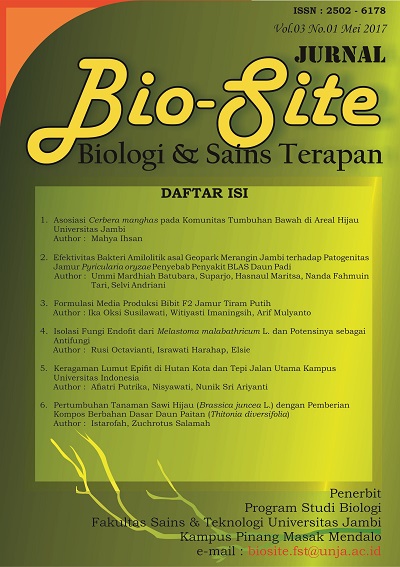Isolation of Fungal Endophytes from Melastoma malabathricum L. and Their Potential as Antifungal
Keywords:
antifungal, fungi, endophyte, Melastoma malabathricum L.Abstract
The aim of this study was to isolation the endophytic fungi from medicinal plant Melastoma malabathricum L. and to investigate their potential antifungal activity. Isolation endophytic fungi was carried out using surface sterilized method. The fungal extracts were assessed for antifungal activity against Candida albicans using agar well diffusion method. A total of 28 isolates fungal endophytes from leaves, stems, flowers and roots of Melastoma malabathricum L. The results showed that of twelev have strong category within inhibit growth of C. albicans. Isolate 18 is endophytic fungi who produced the largest zones of inhibit is 19 mm.
Downloads
References
2. Azoro, C. 2002. Antibacterial Activity of Crude Aqueous of Azadrichtaindica on Salmonella typhi. World J Biotechnol.; 3:347-351.
3. Bérdy, J. 2005. Bioactive Microbial Metabolites. J. Antibiot. 58(1): 1-26.
4. Davis and Stout. 1971. Disc Plate Method of Microbiological Antibiotic Essay. Journal of Microbiology. Vol. 22, No. 4.
5. Frazier, W. C. and D. C. Westhoff. 1988. Food Microbiology. 4th ed. NewYork : McGraw Hill Publ. Co. Ltd.
6. Kusumaningtyas E, Sukmawati L. dan Astuti E. 2008. Evalution of Group of Alpiniagalangan-hexane-Extract against Candida albicansby Bioautography and Thin Layer Chromatography. JITV 13(4). hlm 323-328.
7. Noverita, D. Fitria, dan E. Sinaga. 2009. Isolasi dan Uji Aktivitas Antibakteri Jamur Endofit dari Daun dan Rimpang Zingiberottensii Val. Jurnal Farmasi Indonesia Vol. 4 No. 4: 171-176.
8. Okane, I., P. Srikitikulchai; K. Toyama; T. Læssøe; S. Sivichai; N.H. Jones; A. Nakagiri; W. Potacharoen and K. Suzuki. 2008. Study of Endophytic Xylariaceae in Thailand: Diversity and Taxonomy Inferred from rDNA Sequence Analyses with Saprobes Forming Fruit Bodies in the Field. Mycoscience 49:359–372.
9. S. M. Jofrry, N. J. Yob, M. S. Rofiee, M. M. R. MeorMohd. Affandi, Z. Suhaili, F. Othman, M. A. Abdah, M. N. M. Desa and Z. A. Zakaria, “Melastoma malabathricum (L.) Smith Ethnomedicinal Uses, Chemical Constituents, and Pharmacological Properties: A Review,†Evidence- Based Complementary and Alternative Medicine, Vol. 2012, 2011, p. 48.
10. Son R. and Cheah YK. 2002. Preliminary Screening of Endophytic Fungi from Medical Plants in Malaysia for Antimicrobial and Antitumor Activity. Malaysian Journal of Medical Sciences, 9(2): 23–33.
11. Sulaiman MR, Somchit MN, Israf DA, Ahmad Z, Moin S, Antinociceptive effect of Melastoma malabathricum ethanolic extract in mice, Fitoterapia, 75, 2004, 667-672.
12. Sunilson, J.A.J., Anandarajagopal, K., Kumari, A.V.A.G. and Mohan, S. 2009. Antidiarrhoeal Activity of Leaves of Melastom amalabathricum. Indian J Pharm Sci., 71: 691-695.
13. Tan R.X. and Zou W.X. 2001. Endophytes : A Rich Source Of Functional Metabolites. Nat Prod Rep; 18: 448-459.
14. Tscherter, H. and Dreyfuss. 1992. New Metabolites, Processes for Their Production and Uses. International Application Published Under The Patent Cooperation Treaty (PCT). International Publication. 38 : 28-45.
15. Zhao, J., Xu, L., J. Wang, P. Li, T. Shan and X. Li. 2010. Beauvericin From Endophytic Fungus, Fusariumredolens, Isolated from Dioscoreazingiberensis and Its Antibacterial Activity. Nat. Prod. Commun. 5(5): 811-814.
Downloads
Published
Versions
- 2017-05-31 (1)
- 2017-05-31 (1)
How to Cite
Issue
Section
License
This work is licensed under a Creative Commons Attribution 4.0 International License.
Copyright Notice:
1. Authors retain copyright and grant the journal right of first publication with the work simultaneously licensed under a Creative Commons Attribution 4.0 International License that allows others to share the work with an acknowledgement of the work's authorship and initial publication in this journal.
2. Authors are able to enter into separate, additional contractual arrangements for the non-exclusive distribution of the journal's published version of the work (e.g., post it to an institutional repository or publish it in a book), with an acknowledgement of its initial publication in this journal.
3. Authors are permitted and encouraged to post their work online (e.g., in institutional repositories or on their website) prior to and during the submission process, as it can lead to productive exchanges, as well as earlier and greater citation of published work (The Effect of Open Access)







